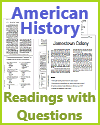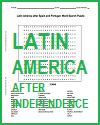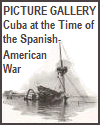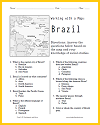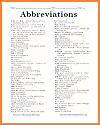Printable DBQ: Document-Based Questions Worksheet for American History Students - Scroll Down to Print |
The Spanish-American War |
Our Islands and Their People was published in 1899, very shortly after the Spanish-American War. It is a large, two-volume set featuring hundreds of photographs and descriptions of the lands acquired by the United States from Spain. The introduction is written by Major-General Joseph Wheeler, who served in both the Spanish-American War and the Philippine War (as well as previously serving in the Civil War). |
| www.studenthandouts.com > U.S. History > Growth and Transformation > Worksheets |
While it is not the purpose of this book to treat especially of the late war with Spain, a brief résumé of the leading events of that memorable contest will not be out of place. The war of 1898 was probably more essentially a war of the people than any other conflict of arms in which this country has been engaged. The long continued series of atrocities practiced by the Spanish officials in Cubaexhausted the patience and aroused the humane sentiments of American citizens to such a degree as to compel positive action upon the part of thegovernment. The destruction of the “Maine” in the harbor of Havana intensified the feeling of indignation throughout the United States; and thisterrible catastrophe, though not the cause of the outbreak of hostilities, certainly hastened the action of Congress in its declaration of war against Spain.  When war was first contemplated the most serious apprehensions prevailed. The navy of Spain, as reported in her official documents, was more formidable than ours; her naval forces numbered two to our one, and her ships as described on paper were quite as powerful and, as some contended, even stronger than those of the American navy. Our coastwise trade became paralyzed, and the cities of New Orleans, Galveston, Mobile, Savannah and Charleston were gorged with merchandise awaiting vessels upon which it could be transported to other ports. All our Atlantic cities felt more or less apprehension, and prompt and effectual measures were taken for their defense. Many persons who had arranged to spend their summer in Europe declined to incur the risk of capture on the high seas and remainedat home. Many of the handsome residences along the Jersey coast were without tenants owing to the general and very natural fear that Spanish cruisers, approaching the Atlantic coast, might easily effect their destruction.
When war was first contemplated the most serious apprehensions prevailed. The navy of Spain, as reported in her official documents, was more formidable than ours; her naval forces numbered two to our one, and her ships as described on paper were quite as powerful and, as some contended, even stronger than those of the American navy. Our coastwise trade became paralyzed, and the cities of New Orleans, Galveston, Mobile, Savannah and Charleston were gorged with merchandise awaiting vessels upon which it could be transported to other ports. All our Atlantic cities felt more or less apprehension, and prompt and effectual measures were taken for their defense. Many persons who had arranged to spend their summer in Europe declined to incur the risk of capture on the high seas and remainedat home. Many of the handsome residences along the Jersey coast were without tenants owing to the general and very natural fear that Spanish cruisers, approaching the Atlantic coast, might easily effect their destruction.Dewey's magnificent victory of May 1st, resulting in the capture or destruction of Admiral Montojo's entire squadron, contributed to allay these apprehensions. Yet, when the American army left Tampa for Santiago, it was considered necessary that the transports bearing the soldiers should be convoyed by a number of our strongest ships of war; and it was not until the destruction of Cervera's fleet in front of Santiago and the capture of that place by the Americans that our people realized the helplessness of the Spanish army. The success of our arms far exceeded the expectations of the most sanguine. Prior to July 1st, no one would have regarded it possible for the purposes of the war to be accomplished in less than one or two years of hard fighting. The expedition to Santiago was considered a mere beginning of the task confronting our government. Success in that quarter was to be followed by a descent upon Havana, where it was supposed the great struggle would take place. It was known that the Spanish army in Cuba exceeded in number two hundred thousand men, and it seemed unreasonable to expect that they would give up the struggle before their military power was exhausted. That this was the view taken by the administration is evidenced by the magnitude of the preparations for the conflict. Our army was increased from twenty-five thousand to two hundred and twenty-five thousand men. Thislarge force was promptly assembled, armed and equipped, and prepared for active service. Ships for war purposes were purchased wherever it was possible to find them; pleasure yachts were secured and converted into fast cruisers; and warlike preparations of all kinds were in progress when, to the surprise of the world, just after the fall of Santiago, Spain made overtures for peace. The army of Santiago, numbering 16,887 officers and men, under the command of Major-General Shafter, sailed from Tampa June 14th, followed a few days later by reinforcements to the number of several thousand. After a quiet and uneventful voyage the transports reached the vicinity of Santiago on the 20th, and with the assistance of the navy commenced disembarking on the morning of the 22nd. General Lawton's division was the first to land, but a portion of the cavalry division, 964 strong, consisting of two squadrons of the First Volunteers, or “Rough Riders,” and one squadron each of the First and Tenth Regular Cavalry–all dismounted–were on shore by the evening of the 23rd, and passed Gen. Lawton's troops at Siboney on the morning of the 24th, in pursuit of a body of Spaniards who had left there on the approach of the Americans and taken up a position about three or four miles further on at a place known as La Guasimas. The location of the Spaniards was accurately known by the Americans and the attack was deliberately planned. The cavalry division advanced by two parallel roads or trails about a mile apart; the right hand column consisted of the regular cavalry under the immediate command of the brigade commander, Gen. Young, accompanied by the division commander andsupported by two Hotchkiss guns; the left hand column comprised the First Volunteers under the command of Col. Leonard Wood. The enemy were discovered shortly after 7 o'clock A.M., and after a warm flight which gave them a good idea of the superb qualities of the American soldier, the Spaniards retreated hastily towards Santiago, leaving us in possession of a beautiful and well-watered camping ground in full view of Santiago and the surrounding country. The remainder of the first week on shore was spent in locating our troops as they advanced from their landing places, and in reconnoitering in our front to discover the location and strength of the defenses of the city. July 1st ushered in the battle of Santiago, which really consisted of two distinct battles, El Caney and San Juan, succeeded by a long siege of the fortified city. The reduction of El Caney, an important outpost northeast of Santiago, was entrusted to General Lawton's division, assisted by General Bates' brigade and a small Cuban force, in all about 7,000 men; while the cavalry and Kent's division of infantry advanced against San Juan, an elevation nearer to and directly east of the city. It was expected that Lawton would take El Caney in one or two hours, and he was then to advance and join Kent and Wheeler in the attack on the main position; but the resistance encountered at El Caney was much stronger and more obstinate than had been anticipated, and the battle raged there for the greater part of the day until the afternoon, when after a most gallant assault the stone fort and blockhouse were taken and the town was in the hands of the victorious Lawton. Meanwhile the cavalry and Kent's division, while crossing the San Juan River and deploying on the other side, found themselves under a galling fire, in consequence of the perfect range of the road acquired by the Spaniards at San Juan, and an immediate advance was necessary. This was made with superb gallantry by both divisions, and before night Fort San Juan and the ridge in front of the city were in our possession. Our strength was terribly depleted by exhaustion, by the casualties of the day, and by the absence of men detailed to care for their dead and wounded comrades; but in spite of our inferiority in numbers, the position so gallantly won was hastilyentrenched and securely held against the attacks of the enemy until the arrival of Bates and Lawton early next morning, and of other reinforcements later on, rendered it impregnable. Fighting continued all day during July 2nd, but with few casualties, both sides being well protected by their entrenchments. On July 3rd, the destruction of Cervera's fleet by our matchless navy aroused the confidence of the besiegers, and in a corresponding degree depressed the spirits of the besieged. July 6th, the gallant Hobson and his men were exchanged for Spanish prisoners captured by the army on the 1st. The siege of the city continued with fighting at intervals, notably on the 10th and 11th, when a simultaneous attack was made by the army and navy. Then followed the negotiations for the surrender of the city. The commissioners appointed to conduct these negotiations were General Wheeler, General Lawton and Lieutenant Miley on the part of the United States, and General Escario, Colonel Frontan and Mr. Robert Mason on the part of Spain. The conferences, which were held beneath the famous ceiba tree, between the lines, occupied the greater part of three days and closed on the 16th of July. On the 17th General Toral formally surrendered to General Shafter his army, about twenty-four thousand strong, the city and division of Santiago, and all the munitions of war contained therein. The Spanish flag which had floated over the old city for nearly four centuries was furled forever, and the Stars and Stripes were triumphantly raisedabove her ancient battlements. Soon after the fall of that city, the Spanish government made overtures for a settlement, and the signing of the Peace Protocol put an end to the short but brilliant campaign in Porto Rico. The Spanish-American War, though comparatively insignificant in point of duration and in the importance of its engagements, was fraught with momentous consequences which can hardly be overestimated. At one blow vast colonial possessions were stricken from the grasp of Spain, and millions of human beings were transferred from a narrow monarchial system of government to a republic founded on the broadest principles of civil and religious liberty. The result of our contest with Spain has brought us addedresponsibilities, broader hopes and loftier aspirations. |
Questions: 1. According to Wheeler, what role did the sinking of the Maine play in causing the war? 2. According to Wheeler, what were the causes of the war? 3. How did Americans feel about the pending war? 4. How was the war won by the United States? 5. What were the results of the Spanish-American War? 6. What are the pros and cons of reading this primary source? Consider the writer and his position. Click here to print. Answers will vary. |
 |
| www.studenthandouts.com > U.S. History > Growth and Transformation > Worksheets |


